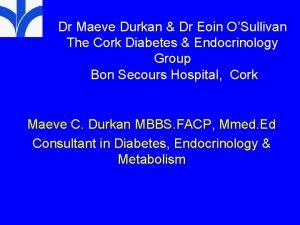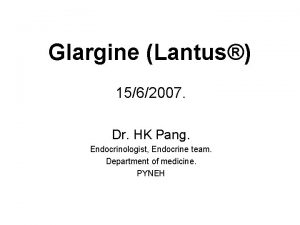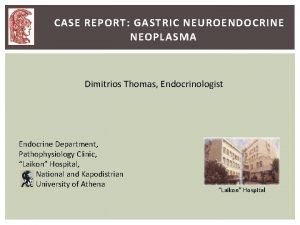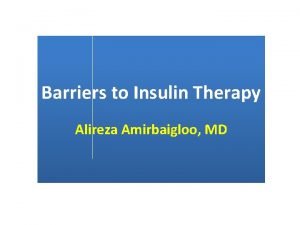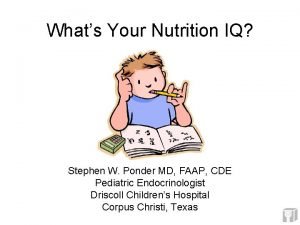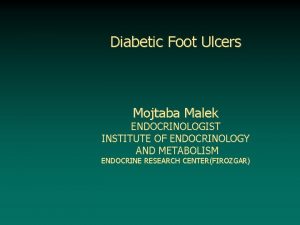H Delshad M D Endocrinologist Research Institute for
























































- Slides: 56


H. Delshad M. D Endocrinologist Research Institute for Endocrine Sciences

Specific Goals in Management of Diabetes • Fasting < 80 -130 mg/d. L • Post-meal < 180 mg/d. L • A 1 C < 7% • Blood Pressure < 130 -140/80 – 90 mm. Hg • LDL < 100 mg/d. L; HDL > 45 mg/d. L • Triglycerides < 150 mg/d. L

Relative Risk of Progression of Diabetes Complications (DCCT) Mean A 1 C DCCT Research Group, N Engl J Med 1993, 329: 977 -986.

Effect of A 1 C On Complications in the UKPDS Study %60 A 1 C 50 5. 5% 40 6. 5% 7. 5% 8. 5% 9. 5% 10. 5% 30 20 10 0 Hb. A 1 C Myocardial Infarction Microvasc Disease

Uncontrolled hyperglycaemia is a global problem Proportion of patients achieving target Hb. A 1 c (%) Prevalence data 80 Hb. A 1 c <7. 5% 67 60 Hb. A 1 c ≤ 7. 0%* 51 40 Hb. A 1 c <7. 0%* 37 20 0 CHINA (CODIC-2)1 CANADA (DICE)2 USA (NHANES)3 Hb. A 1 c ≤ 6. 5%* 31 EUROPE (CODE-2)4 *National guidelines target Hb. A 1 c 1 Chen Xingbao, Chinese Health Economics 2003; Tang Ling, China Diabetic Journal 2003; 2 Harris SB, et al. Diabetes Res Clin Pract 2005; 70: 90– 7; 3 Saydah SH, et al. JAMA 2004; 291: 335– 42; 4 Liebl A, et al. Diabetologia 2002; 45: S 23– 8

Risk of complications Correlation between a 1% A 1 C decrease and reduced risk of complication 21% 43% 14% 37% Cardiovascular complications Amputations or death Microvascular from peripheral complications vascular disease (p < 0. 0001) Diabetes-related death Myocardial infarction All-cause mortality (p < 0. 0001) Stratton IM, et al. BMJ. 2000: 321: 405 -412.


Beta-cell function continues to decline 100 75 -Cell Function (%) 50 25 0 IGT -12 -10 Postprandial Hyperglycemia -6 Type 2 Diabetes Phase I -2 0 Type 2 Diabetes Phase II 2 Years From Diagnosis 6 Type 2 Diabetes Phase III 10 14

Progressive Loss of -Cell Function in T 2 DM: UKPDS Nonobese Patients Obese Patients 100 80 80 60 60 40 40 20 20 0 1 2 3 4 5 6 7 0 1 2 Years From Randomization Conventional Sulphonylurea 3 4 5 6 Metformin 7 -Cell Function, % 100

11

Approach to hyperglycemia management: Several factors should be considered

Inzucchi et al. Diabetes Care 2015; 38: 140 -149

Expected Hb. A 1 c reduction according to intervention Intervention Lifestyle interventions Metformin Sulfonylureas Insulin Glinides Thiazolidinediones -Glucosidase inhibitors GLP-1 agonist Pramlintide DPP-IV inhibitors Nathan DM, et al. Diabetes Care 2009; 32: 193 -203. Expected ↓ in Hb. A 1 c (%) 1 to 1. 5 to 1 to 0. 5 to 2% 2% 2% 3. 5% 1. 5%1 1. 4% 0. 8% 1. 0% 0. 8% 14

Types of Insulin Ø More than 20 types of insulin Ø Different time of onset and duration of action. Ø Among the criteria considered in choosing insulin are: ○ How soon it starts working (onset) ○ When it works the hardest (peak time) ○ How long it lasts in the body (duration)

Available insulin injections Insulin Type Product Onset Peak Duration Novolog Apidra Humalog 10 -30 min. 0. 5 -3 h. 3 -5 h. Humulin R Novolin R 0. 5 -1 h. 2 -5 h. Up to 12 h. Humulin N Novolin N 1. 5 -4 h. 4 -12 h. Up to 24 h. Levemir Lantus Novomix-30 0. 75 -4 h. Minimal peak Up to 24 h. Rapid-Acting Aspart Glulisine Lispro Short-Acting Regular Intermediate-Acting NPH insulin Long-Acting Detemir Glargine Premixed

Regular Insulin • • • Exist in solution in hexameric form Onset of action : 0. 5 – 1 hour after SC It peaks 2 – 4 hours after SC The duration of action range 8 – 10 hours It peaks much later than the blood glucose rise • Exerts its effect for too long • Risk of hyperglycemia in the first 30 minutes and hypoglycemia many hours after meals

Rapid Analogs ○ Lispro ○ Aspart ○ Glulysine • • Exist in solution in monomeric form Onset of action : up to 0. 5 hour after SC Peaks 1– 2 hours after SC The duration of action up to 4 hours Peak when the blood glucose rise No risk of hyper- or hypoglycemia Dose given immediately pre-meal

PHARMACOKINETICS : Slow dissolution of the Glargine hexamers at the injection site results in a relatively constant release with no pronounced peak over a period of up to 24 hours. Onset of action = 2 hours Peak = flat Duration = 24 hours

Insulin Time Action Curves Relative Insulin Effect Rapid (Lispro, Aspart , Glulysine) Short (Regular) Intermediate (NPH) Long (Glargine) 0 2 4 6 8 10 Time (Hours) 12 14 16 18 20

T 2 DM Treatment: ADA/EASD position statement 2017 Healthy eating, weight control, increased physical activity Initial monotherapy MET Not at target Hb. A 1 c after ~3 months Two-drug combinations SU TZD DPP-4 i SGLT-2 i GLP-1 RA Insulin SU TZD Insulin SGLT-2 i SU TZD GLP-1 RA Insulin SU TZD Insulin TZD DPP-4 i GLP-1 RA SGLT-2 i Not at target Hb. A 1 c after ~3 months Three-drug combinations Not at target Hb. A 1 c after 3 -6 months combination therapy with insulin TZD DPP-4 i GLP-1 RA Insulin SGLT-2 i More complex strategies Inzucchi et al. Diabetes Care 2015; 38: 140 -149 SU DPP-4 i GLP-1 RA Insulin SGLT-2 i Basal Insulin + GLP-1 RA or Prandial Insulin

T 2 DM Treatment: ADA/EASD position statement 2017 Initial therapy A 1 c is≥ 9% Consider Dual therapy *A 1 c≥ 10% *BS > 300 mg *Markedly symptomatic Consider Combination injectable therapy

A logical stepwise approach Basal plus Basal insulin Basal + 2 prandial Basal bolus Basal + 3 prandial Basal + 1 prandial once daily (treat-to-target) Lifestyle + Metformin ± SU Hb. A 1 c ≥ 7. 0%, FBG on target PPG ≥ 160 mg/d. L Time Adapted from Raccah et al. Diabetes Metab Res Rev 2007; 23: 257.

Treatment intensification routes as the diabetes progresses (ADA 2017) Full Basal-bolus Basal-plus TDS Premix Basal Insulin BID Premix Ins. Lifestyle + Metformin 1 Additional OADs 2 3 4 5

How do we define insulin initiation? Hb. A 1 c Initiate Setting Hb. A 1 c goal for a particular patient Starting insulin therapy basal bolus Optimise Dose titration to ensure that the patient receives the maximum benefit from the prescribed treatment Intensify Modification of the insulin regimen: adding to or changing therapy in order to maintain euglycemia Mosenzon O, et al. Diabetes Care 2013; 36(2): S 212 -S 218.

Insulin Treatment Patterns: common strategies Starting regimens Intensification regimens Basal insulin + OADs Premix BID or TID Premix insulin OD or BID Basal–bolus therapy Prandial insulin

Treatment intensification routes as the diabetes progresses Full Basal-bolus Basal-plus TDS Premix Basal Insulin BID Premix Ins. Lifestyle + Metformin Additional OADs 3

Initiate Basal Insulin Usually with Metformin +/- other noninsulin agent Start: 0. 1 – 0. 2 U/kg/day Adjust : 2 – 4 U once or twice weekly to reach FBG target If A 1 c not controlled Add 1 rapid-acting insulin before largest meal Start: 0. 1 U/kg or 4 units Adjust : 1– 2 U once or twice weekly until SMBG target reached Add GLP-1 Change to premixed insulin twice daily Start: divide current basal dose into 2/3 AM, 1/3 PM or 1/2 + 1/2 Adjust : 1– 2 U once or twice weekly until SMBG target reached If A 1 c not controlled Add ≥ 2 rapid-acting insulin before meal Change to premixed insulin 3 times daily

Titrate basal insulin as long as FPG > target INITIATE • Bedtime or morning long-acting insulin • Daily dose: 10 units or 0. 2 units/kg Check FPG daily • Increase dose by 2 units every 3 days TITRATE until FPG is (70– 130 mg/d. L) • If FPG is >180 mg/d. L, increase dose by 4 units every 3 days MONITOR Continue regimen and check Hb. A 1 c every 3 months In the event of hypoglycemia or FPG level < 70 mg/d. L • Reduce bedtime insulin dose by 4 units, or by 10% if >60 units

Once daily basal insulin maintains Hb. A 1 c target for at least 2. 5 years Reduced Hypoglycaemia 10 Hb. A 1 C (%) 9 8 -1. 6 7. 0 9 30 8. 6 7 6 0 Time (months) Schreiber S et al. . Curr Med Res Opin 2007 Dec; 23(12): 3131 -6.

Initiate Basal Insulin Usually with Metformin +/- other noninsulin agent Start: 0. 1 – 0. 2 U/kg/day Adjust : 2 – 4 U once or twice weekly to reach FBG target If A 1 c not controlled Add 1 rapid-acting insulin before largest meal Start: 0. 1 U/kg or 4 units Adjust : 1– 2 U once or twice weekly until SMBG target reached Change to premixed insulin twice daily Start: divide current basal dose into 2/3 AM, 1/3 PM or 1/2 + 1/2 Adjust : 1– 2 U once or twice weekly until SMBG target reached If A 1 c not controlled Add ≥ 2 rapid-acting insulin before meal Change to premixed insulin 3 times daily

Change from Basal to Premixed Insulin twice daily Start: Divide current basal dose into 2/3 AM & 1/3 PM or 1/2 AM & 1/2 PM Adjust: Increase the dose 1 -2 U or 10 -15% once-twice weekly until SMBG target is reached. For Hypo: Determine and address cause; decrease corresponding dose 2 -4 U or 1020% Inzucchi et al. Diabetes Care 2015; 38: 140– 149

Intensifying from BIAsp OD to BID Unnikrishnan et al. Int J Clin Pract 2009; 63: 1571– 7

Intensifying from BIAsp BID to TID Unnikrishnan et al. Int J Clin Pract 2009; 63: 1571– 7

BIAsp-30 dose titration • BIAsp 30 offers a simple dose titration based on FBG or predinner SMBG – For once-daily dosing, the evening dose titration is done based on pre-breakfast blood glucose level – For twice-daily BIAsp 30, the morning dose is titrated on pre-dinner blood glucose level and evening dose is titrated based on pre-breakfast blood glucose level – For three-times daily BIAsp 30, the morning dose is titrated based on the pre-lunch blood glucose, midday dose is titrated on pre-dinner blood glucose and evening dose is titrated on pre-breakfast blood glucose

Which patient should be offered a premix versus basal- bolus/basal plus regimen? Premix insulin analogs Basal plus/basal bolus Patient preference Type 1 diabetes (any age) Older age Younger age Need assistance with injections Highly motivated and compliant Organized lifestyle Active lifestyle Two meals a day or evening main meal High variability in eating habits Mosenzon O, et al. Diabetes Care 2013; 36(2): S 212 -S 218.

Basal-plus therapy Vs. premixed insulin All to Target Study ● 60 weeks randomized, open label : Basal plus vs. Basal stepwise bolus, vs. 2 premixed Riddle M. C, et al, Diabetes, Obesity and Metabolism, 2014

All to Target Study Riddle M. C, et al, Diabetes, Obesity and Metabolism, 2014

All to Target Study

Glucose triad of diabetes management PPG FPG Monnier et al. Diabetes Care 2007; 30: 263– 9; Monnier et al. Diabetes Care 2003; 26: 881– 5 Hb. A 1 c

Type 2 DM Treatment: Key points • Glycaemic control is dependent on adequate regulation of FPG and PPG levels • Fasting and postprandial hyperglycaemia are associated with overall and CV mortality • Reducing PPG levels may lower CV risk, while reducing FPG can reduce the risk of microvascular complications in poorly controlled patients

Maintain control as diabetes progresses • Long-term diabetes management aims to: – Keep Hb. A 1 c below 7% – Control PPG as well as FPG : both are important in overall glycaemia • Patients spend 50% of the day in the postprandial state • PPG is not directly targeted by basal insulin 1. American Diabetes Association. Diabetes Care 2007; 30(Suppl 1): S 4–S 41 2. Monnier L. Eur J Clin Invest 2000; 30(Suppl 2): 3– 11. 3. Hirsch IB et al. Clinical Diabetes 2005; 23(2): 78– 86.

Relative contribution of PPG and FPG to diurnal hyperglycaemia (%) Relative contributions of PPG and FPG to diurnal hyperglycaemia 100 Postprandial glucose 90 80 70 Fasting plasma glucose 60 50 40 30 20 10 0 <7. 3– 8. 4 8. 5– 9. 2 9. 3– 10. 2 Hb. A 1 c quintiles Monnier et al. Diabetes Care 2003; 26: 881– 5 >10. 2

Treatment intensification routes as the diabetes progresses Full Basal-bolus Basal-plus TDS Premix Basal Insulin BID Premix Ins. Lifestyle + Metformin 1 Additional OADs 2 3 4 5

Basal Insulin Long acting analogous Glargine , Detemir , Degludeg • They are more predictable than conventional insulins and allow simplified insulin-replacement strategies.

Basal plus Prandial Insulin Different types of regimens : • Aspart, Glulisine and Lispro Prandial insulin (before meals ) • Glargine, , Detemir , Degludeg Basal insulin ( at bedtime or in the morning )


How is insulin normally secreted ? Bolus Basal Bolus (50%) Serves to control postprandial hyperglycemia in response to food intake. Basal ( 50%) Serves to balance the rate of hepatic glucose production and peripheral uptake during overnight and prolonged periods between meals.

Determining initial insulin dosages for basal-bolus • Total Daily Dose (TDD) : 0. 2 – 0. 5 U/kg/day • Bedtime Glargine : 35 – 50 % TDD • Meal Boluses Rapid-acting ( % of TDD): - Breakfast = 20 % - Lunch = 15 % - Dinner = 15 %

Determining initial insulin dosages for basal-bolus • 35 -y old man, W: 90 kg Total Daily Dose = 45 IU • Bedtime Glargine: 45 X 0. 50= 22 IU • Meal Boluses Rapidacting: - Breakfast = 45 X 0. 20 = 9 IU - Lunch = 45 X 0. 15 = 7 IU - Dinner = 45 X 0. 15 = 7 IU

Initial Dosing Guidelines for Insulin Glargine Type of Patient Insulin-naïve Switched from NPH once daily Switched from NPH Appropriate Glargine Dosage Initiate at 10 IU once daily , titrate appropriately Initiate at same dosage; titrate appropriately Reduced total daily dose by 20%-30% compared to NPH; titrate appropriately twice daily Titration of Glargine to a final dose range of 2 to 100 IU is suggested

Making adjustment in insulin dosage ►Insulin Sensitivity Factor (ISF) ●ISF (For human insulin)= 1500 ÷ TDD ●ISF (For analogue insulin)= 1800 ÷ TDD Example: TDD= 50 (human insulin), ISF = 1500 ÷ 50 = 30 (It means that each unit of bolus decreases blood glucose by 30 mg/dl) ►Based on food intake : - 1. 0 U of Regular Insulin for every 15 gr. CAH

Supplemental Insulin for Correction of Hyperglycemia Regular insulin, insulin Aspart /Glulisine / Lispro can be used to correct for hyperglycemia: • In general, 1 -2 units of insulin will lower the blood glucose by 30 -50 mg/dl. • For every 50 mg/dl above the premeal glucose target (e. g. , 150 mg/dl), add 1 unit of insulin • If premeal glucose is 250 mg/dl, 2 units of insulin should be added to the usual dose of premeal insulin.

Adjustments for Exercise improves insulin sensitivity : • For morning exercise : Reduce pre-breakfast insulin (~25%) • For early-afternoon exercise : Reduce the pre-lunch insulin • For evening exercise Reduce pre-dinner insulin


Figure. Simple flow diagram showing the suggested treatment intensification routes available to patients with T 2 D as the disease progresses. BID = twice daily; DPP-4 i = dipeptidyl peptidase-4 inhibitor; OAD = oral antidiabetic drug; SU = sulfonylurea; T 2 D = typ. . . Luigi F. Meneghini Intensifying Insulin Therapy: What Options Are Available to Patients with Type 2 Diabetes? The American Journal of Medicine, Volume 126, Issue 9, Supplement 1, 2013, S 28–S 37 http: //dx. doi. org/10. 1016/j. amjmed. 2013. 06. 011
 Jeff lobe
Jeff lobe Dr maeve durkan
Dr maeve durkan Dr. alireza amirbaigloo, md, endocrinologist
Dr. alireza amirbaigloo, md, endocrinologist Endocrinologist newcastle
Endocrinologist newcastle Dr pang endocrinologist
Dr pang endocrinologist Dimitrios thomas endocrinologist
Dimitrios thomas endocrinologist Dr. alireza amirbaigloo, md, endocrinologist
Dr. alireza amirbaigloo, md, endocrinologist Dr ponder endocrinologist
Dr ponder endocrinologist Endocrinologist in parbhani
Endocrinologist in parbhani Sulfonylureas
Sulfonylureas Endocrinologist lifestyle
Endocrinologist lifestyle Dexamethasone suppression test
Dexamethasone suppression test Dr swade endocrinologist
Dr swade endocrinologist Iso 22301 utbildning
Iso 22301 utbildning Novell typiska drag
Novell typiska drag Tack för att ni lyssnade bild
Tack för att ni lyssnade bild Returpilarna
Returpilarna Varför kallas perioden 1918-1939 för mellankrigstiden
Varför kallas perioden 1918-1939 för mellankrigstiden En lathund för arbete med kontinuitetshantering
En lathund för arbete med kontinuitetshantering Underlag för särskild löneskatt på pensionskostnader
Underlag för särskild löneskatt på pensionskostnader Personlig tidbok för yrkesförare
Personlig tidbok för yrkesförare Anatomi organ reproduksi
Anatomi organ reproduksi Förklara densitet för barn
Förklara densitet för barn Datorkunskap för nybörjare
Datorkunskap för nybörjare Tack för att ni lyssnade bild
Tack för att ni lyssnade bild Hur skriver man en tes
Hur skriver man en tes För och nackdelar med firo
För och nackdelar med firo Nyckelkompetenser för livslångt lärande
Nyckelkompetenser för livslångt lärande Påbyggnader för flakfordon
Påbyggnader för flakfordon Tryck formel
Tryck formel Offentlig förvaltning
Offentlig förvaltning Lyckans minut erik lindorm analys
Lyckans minut erik lindorm analys Presentera för publik crossboss
Presentera för publik crossboss Teckenspråk minoritetsspråk argument
Teckenspråk minoritetsspråk argument Vem räknas som jude
Vem räknas som jude Klassificeringsstruktur för kommunala verksamheter
Klassificeringsstruktur för kommunala verksamheter Mjälthilus
Mjälthilus Bästa kameran för astrofoto
Bästa kameran för astrofoto Centrum för kunskap och säkerhet
Centrum för kunskap och säkerhet Programskede byggprocessen
Programskede byggprocessen Mat för unga idrottare
Mat för unga idrottare Verktyg för automatisering av utbetalningar
Verktyg för automatisering av utbetalningar Rutin för avvikelsehantering
Rutin för avvikelsehantering Smärtskolan kunskap för livet
Smärtskolan kunskap för livet Ministerstyre för och nackdelar
Ministerstyre för och nackdelar Tack för att ni har lyssnat
Tack för att ni har lyssnat Hur ser ett referat ut
Hur ser ett referat ut Redogör för vad psykologi är
Redogör för vad psykologi är Borstål, egenskaper
Borstål, egenskaper Tack för att ni har lyssnat
Tack för att ni har lyssnat Borra hål för knoppar
Borra hål för knoppar Orubbliga rättigheter
Orubbliga rättigheter Fr formel
Fr formel Tack för att ni har lyssnat
Tack för att ni har lyssnat Rita perspektiv
Rita perspektiv Vad är verksamhetsanalys
Vad är verksamhetsanalys Tobinskatten för och nackdelar
Tobinskatten för och nackdelar

